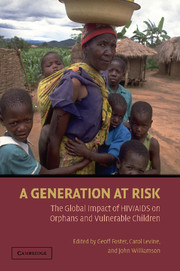Book contents
- Frontmatter
- Contents
- Foreword
- Preface
- Contributors
- Introduction: HIV/AIDS and Its Long-Term Impact on Children
- 1 Family and Community-Based Care for Children Affected by HIV/AIDS: Strengthening the Front Line Response
- 2 Strengthening Households and Communities: The Key to Reducing the Economic Impacts of HIV/AIDS on Children and Families
- 3 The Response of the Educational System to the Needs of Orphans and Children Affected by HIV/AIDS
- 4 Psychosocial Impact of the HIV/AIDS Epidemic on Children and Youth
- 5 Human Rights and Children Affected by HIV/AIDS
- 6 Religion and Responses to Orphans in Africa
- 7 Making the Right Choices in the Asia-Pacific Region: Protecting Children and Young People from HIV and Its Impacts
- 8 Troubled Tapestries: Children, Families, and the HIV/AIDS Epidemic in the United States
- 9 Interventions to Support Children Affected by HIV/AIDS: Priority Areas for Future Research
- 10 Finding a Way Forward: Reducing the Impacts of HIV/AIDS on Vulnerable Children and Families
- Chronology of Important Events
- Resource Guide
- Index
- References
2 - Strengthening Households and Communities: The Key to Reducing the Economic Impacts of HIV/AIDS on Children and Families
Published online by Cambridge University Press: 05 June 2012
- Frontmatter
- Contents
- Foreword
- Preface
- Contributors
- Introduction: HIV/AIDS and Its Long-Term Impact on Children
- 1 Family and Community-Based Care for Children Affected by HIV/AIDS: Strengthening the Front Line Response
- 2 Strengthening Households and Communities: The Key to Reducing the Economic Impacts of HIV/AIDS on Children and Families
- 3 The Response of the Educational System to the Needs of Orphans and Children Affected by HIV/AIDS
- 4 Psychosocial Impact of the HIV/AIDS Epidemic on Children and Youth
- 5 Human Rights and Children Affected by HIV/AIDS
- 6 Religion and Responses to Orphans in Africa
- 7 Making the Right Choices in the Asia-Pacific Region: Protecting Children and Young People from HIV and Its Impacts
- 8 Troubled Tapestries: Children, Families, and the HIV/AIDS Epidemic in the United States
- 9 Interventions to Support Children Affected by HIV/AIDS: Priority Areas for Future Research
- 10 Finding a Way Forward: Reducing the Impacts of HIV/AIDS on Vulnerable Children and Families
- Chronology of Important Events
- Resource Guide
- Index
- References
Summary
There is widespread and well-founded concern about the impacts of HIV/AIDS on children and families. Most major studies that discuss the effects of the pandemic share many of the same conclusions:
The HIV/AIDS pandemic is an evolving and broad-scale disaster.
AIDS is not only a health issue but also a development crisis.
The pandemic is unraveling years of hard-won gains in economic and social development.
The economic toll of AIDS starts with eroding the resources of the person living with the disease, then depletes the resources of the immediate and extended family, and eventually threatens to overwhelm the capacity of communities to act as a “safety net.”
Agencies and donors pay too little attention to the massive scale of the impact, and their efforts reach only a small fraction of individuals, families, and communities affected by HIV/AIDS.
The fundamental challenge is to develop coordinated, multisectoral interventions that make a difference over the long haul at a scale that approaches the magnitude of the HIV/AIDS pandemic.
There is deep concern in both the most affected regions and the industrialized world about young people affected by AIDS. It is clear that these children and adolescents face daunting challenges. Many analysts fear that the unprecedented strain on extended families and communities will cause societal breakdown, and that the wider world is not doing much to help.
While these concerns are well-founded, they reflect only part of the reality. Despite seemingly overwhelming challenges, families and communities are responding creatively in devising ways to sustain their initiatives.
- Type
- Chapter
- Information
- A Generation at RiskThe Global Impact of HIV/AIDS on Orphans and Vulnerable Children, pp. 37 - 65Publisher: Cambridge University PressPrint publication year: 2005
References
- 6
- Cited by



